 |
 |
 |
| |
Highly Potent Protease Inhibitors with Novel Escape Pathways
|
| |
| |
Reported by Jules Levin
16th Intl HIV Drug resistance Workshop, June 12-16, 2007, Barbados
E Afonina1, SV Gulnik1, M Eissenstat1, H Yokoe1, B. Yu1, NT Parkin2, and JW
Erickson1
1Sequoia Pharmaceuticals, Inc., Gaithersburg, Maryland, USA
2Monogram Biosciences, Inc., San Francisco, California, USA
Author Conclusions
SPI-390 and SPI-457 represent a group of highly potent protease inhibitors of wild type HIV
Both compounds maintain nanomolar potency against worst-case scenario MDR HIV isolates.
Selection of viruses resistant to either compound was a very slow process, and required multiple passages with small incremental increases of concentration.
Escape pathways were novel and different for SPI-390 and SPI-457 compared to SPI-256 and reference PIs
SPI-390 and SPI-457 represent potent new generation antiviral agents for first line and salvage therapy
INTRODUCTION
The incidence and prevalence of multidrug resistant (MDR) virus is becoming a major obstacle in HIV control efforts. Mutations within the protease gene that confer clinical drug resistance have emerged for all of the FDA-approved HIV protease inhibitors (PIs).
We have discovered a series of novel HIV-1 PIs that retain high potency against both wt and MDR-HIV quasi-species. The in vitro activities of these compounds against a wide range of MDR HIV are superior in potency to those of a variety of approved HIV PIs.
Selected compounds with the desired antiviral resistance profile were prioritized based on preclinical analysis and one compound, SPI-256, emerged as one of the first candidates for clinical development. (note from Jules: clinical trials for 256 are starting)
We report here the evaluation of two novel PIs, SPI-390 and SPI-457 with high potency against worst case scenario MDR HIV strains, and with a slower rate of in vitro resistance development and novel escape pathways compared to SPI-256.
METHODS
Enzyme inhibition assay:
Recombinant wild type and mutant HIV protease (PR) were expressed in E.coli cells, purified to apparent homogeneity by ion-exchange chromatography in 8 M urea, and refolded at pH 7.0. Inhibition constants were determined using a fluorogenic substrate in 0.05 M sodium phosphate buffer, pH 6.5
Antiviral activity and resistance selection assays:
Antiviral activity was evaluated using cell protection assay in MT-4 cells infected with WT (HXB2) HIV-1 or recombinant MDR HIV-1 mutants.
Monogram Biosciences PhenoSense HIV assay was used to evaluate the resistance profile of SPI-256 against a panel of WT and MDR HIV.
In vitro selection experiments were performed by passaging WT-HXB2 HIV in MT4 cells in the presence of increasing concentrations of test compounds. Virus growth was monitored by p24 gag ELISA.
Viral RNA was extracted from passaged virus, and a 1000 bp PCR fragment containing protease region and p7/p1 gag and p1/p6 gag cleavage sites was subjected to population sequencing.
RESULTS
We have implemented a structure-based approach for the design of novel HIV protease inhibitors (PIs) with high potency against WT and MDR viruses. The most highly conserved atomic interactions were identified using complexes of structurally different PIs with WT and drug-resistant HIV PRs.
Several series of inhibitors that preferentially interact with this constellation of conserved atoms within the active site were designed and synthesized.
Inhibitors were first prescreened in the enzyme-based assay using WT and selected MDR PRs. Resistance profiles were then evaluated in a 5 day cell-based antiviral assay using an in-house panel of clinically derived MDR viruses. Several promising inhibitors were evaluated further against a selected panel of patient-derived WT and MDR HIV strains using the Monogram Biosciences PhenoSense HIV assay.
Both SPI-390 and SPI-457 are highly active against purified wild-type (WT) and mdr-HIV proteases with inhibition constants (Ki) in the picomolar range. The enzyme inhibitory activity of SPI-256 against WT and mutant enzymes is superior to that of a variety of approved HIV protease inhibitors including lopinavir and atazanavir (Table 1).
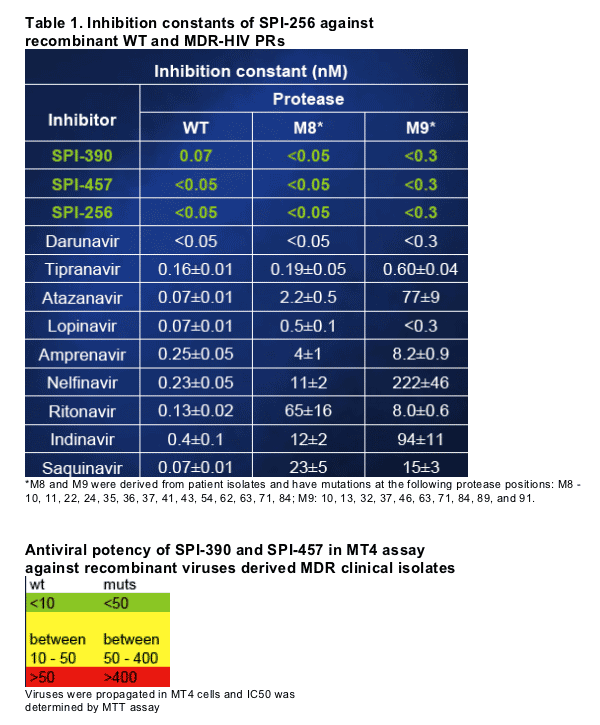
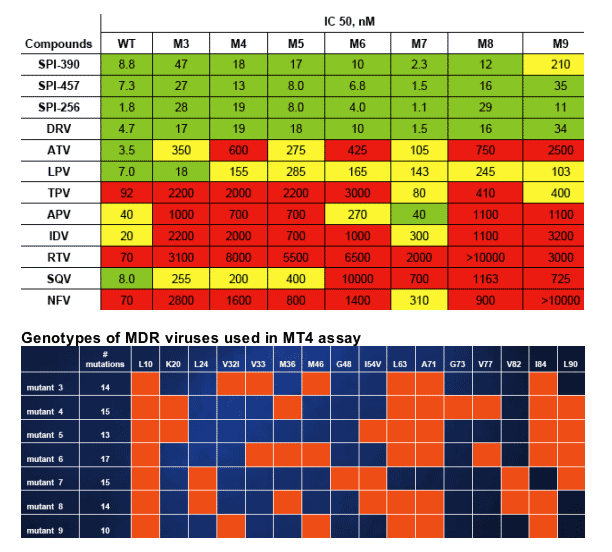
Evaluation of SPI-390 and SPI-457
in PhenoSense Assay
SPI-390 and SPI-457 exhibited IC50 values of 0.6 nM and of 0.3 nM, respectively against WT HIV, and were more potent than FDA-approved PIs including darunavir (IC50 0.8-74 nM).
Both SPI-390 and SPI-457 retain high potency against the selected panel of patient isolates with > 50-fold resistance to reference PIs and/or 6 primary PI mutations, although efficacy is reduced compared to WT:
--The average SPI-390 and SPI-457 IC50 values were 8.4 nM (range: 1.5-21 nM), and 6.8 nM (range: 1.2 - 13 nM), respectively. Average IC50 range for reference PIs: 27.1 to >2,600 nM
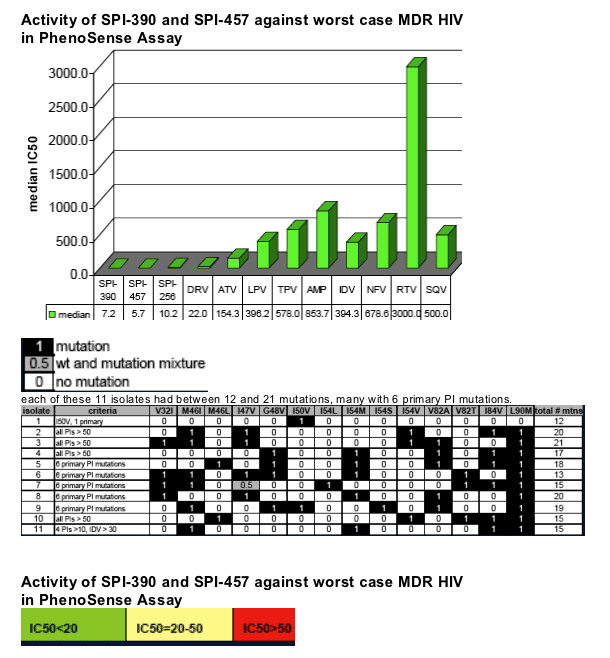
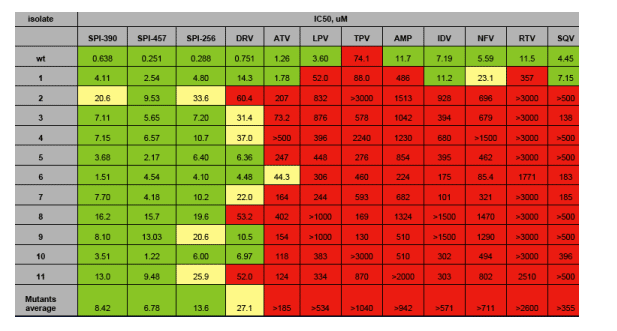
Resistance selection experiments:
In vitro biochemical and antiviral studies showed that most of the single PI mutants were suppressed in the presence of SPI-390 and SPI-457.
Thus, the barrier to emergence of drug resistance along any of the commonly observed evolutionary pathways should be high.
To propagate virus in the presence of increasing concentrations of both compounds, a strategy developed for selecting SPI-256-resistant viruses was adopted. Wild type HIV-1 was initially grown at concentration equal to the IC50
and drug concentrations were increased in very small increments (less than 0.5x increase).
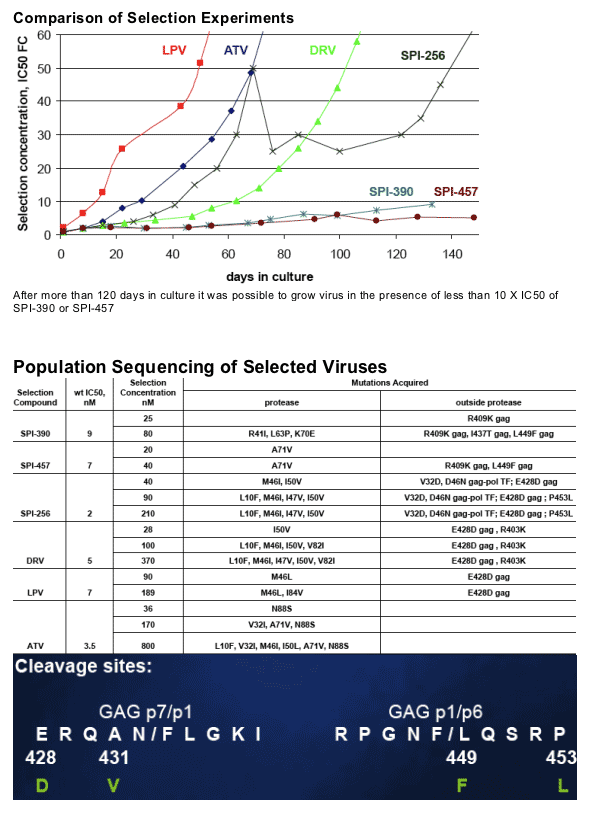
|
| |
|
 |
 |
|
|